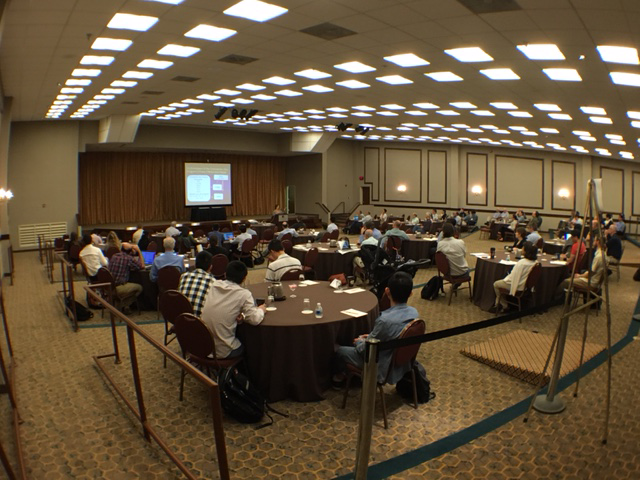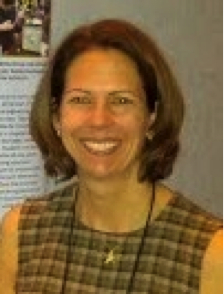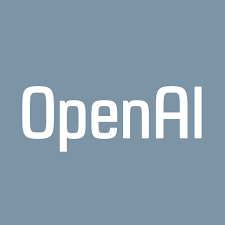Chesapeake Community Modeling Program
CCMP Newsletter | September 2016
Volume 9, Issue 2
Introduction
Welcome to the fall 2016 edition of the CCMP Newsletter. Please read on for all of the latest news related to the CCMP and the open source world of environmental modeling. We hope you enjoy this edition and, as always, please contact Dave Jasinski if you have any questions or comments.

Contents
1. CCMP News in brief
2. Open Source on the March
3. Featured Modeler: Meng Xia
4. Featured Model: FVCOM-ICM
5. Upcoming Meetings
1. CCMP News in Brief
Chesapeake Modeling Symposium 2016
 The fifth Chesapeake Modeling Symposium was held June 1st & 2nd in Williamsburg, VA. A little more than 100 people attended this year’s symposium so the numbers were slightly down from previous years. Nonetheless, the participants were enthusiastic and the meeting was a great success. There were 61 presentations over the two days. On the morning of day 1, there were 3 plenary speakers:
The fifth Chesapeake Modeling Symposium was held June 1st & 2nd in Williamsburg, VA. A little more than 100 people attended this year’s symposium so the numbers were slightly down from previous years. Nonetheless, the participants were enthusiastic and the meeting was a great success. There were 61 presentations over the two days. On the morning of day 1, there were 3 plenary speakers:
- Rich Batiuk, CBPO - The Challenge of Transparency in Management modeling – The Chesapeake Bay Program Experience
- Kelly Shenk, CBPO - Speaking your mind and moving forward - Engaging Agriculture and Environmental Groups in Constructive Ways to Achieve Chesapeake Bay Restoration
- Jeff Blair, FSU/FCRC Consensus Center - Collaborative Approaches to Planning, Rule Making, and Dispute Resolution – How to Facilitate the Public's Involvement in Public Policy Development and Implementation
On the morning of day 2 there was a panel discussion titled “The Challenge of Transparency in Management Modeling – What is Transparency, Why do we Need It, and How Do We Get There?”. The discussion was moderated by Dr. Kevin Sellner, former director of the Chesapeake Research Consortium. This panel discussion stimulated strong audience participation and considerable debate.
Many of the presentations given at the Symposium are viewable on the Open Science Framework at - https://osf.io/jymb4/. If you attended the symposium and have any thoughts or comments about it or ideas for future symposia please don’t hesitate to contact Dave Jasinski.
Chesapeake Guardian Award: Gary Shenk
At the Chesapeake Modeling Symposium, Gary Shenk, long time member of the Chesapeake Bay Program Modeling Team, was awarded the Sellner Chesapeake Guardian Award. The “Sellner Chesapeake Guardian Award” was first awarded to Dr. Kevin Sellner at the 2014 Chesapeake Modeling Symposium for “Exceptional Service Dedicated to the Advancement of Community Modeling in the Chesapeake Bay Region”. The CCMP has established this award in Dr. Sellner’s honor in appreciation for his more than 30 years of research, guidance and service to the Chesapeake Bay research, management and policy maker communities.
Individuals nominated should have demonstrated sustained contributions in the areas of research, guidance, and service to the advancement of community modeling in the Chesapeake Bay region. The nominee’s work should have benefited efforts in research, management and policy maker communities for the Chesapeake Bay and its watershed.
Reasons given for by nominating committee members for Shenk to receive the award included:
- The “openness” with which Gary has approached the task of developing the suite of models he uses,
- The extent to which he has always encouraged and promoted the contributions of others,
- The manner in which he has embraced the “multiple models” concept in his most recent activities to redefine watershed modeling for Phase 6,
- He, perhaps more than anyone else in the Bay Program, has embraced the “open source” model, fully releasing the Phase 5.3 model through both the Bay Program and CCMP,
- He has emerged as important liaison between the Bay Program modeling community and the academic community. He is widely viewed as a trusted honest broker on both sides of this fence,
- He has tirelessly led the Bay Program watershed modeling effort, working for more than 20 years trying to “get it right”. He has always been responsive to “advice” from the research community and stakeholders.
Next time you see Gary, please congratulate him on receiving this award!
New and Departing Members of the CCMP
The CCMP is bidding fair well to two long-term members of its steering committee. Kevin McIlhany of the US Navel Academy and Howard Townsend of NOAA are stepping down after several years of service to the committee. We’d like to thank them for their valuable support to the CCMP and its mission over the last several years!
 Replacing Kevin McIlhany will by Cecily Steppe, also of the Naval Academy. Cecily received her B.S. in biology from Yale and her Ph.D. in Oceanography from the University of Delaware. Her research focuses on the physical and biological processes that drive population dynamics of commercially and ecologically important marine and estuarine taxa. To do this, she works on the early life history of estuarine invertebrates, in particular larval transport and recruitment. She serves as the Director of the US Naval Academy’s Center for Chesapeake Bay Observation and Modeling, an interdisciplinary research group that brings faculty and students together from across the Academy to focus on Chesapeake Bay issues. Cecily is looking forward to bring her interdisciplinary experience to CCMP and is excited to join the steering committee.
Replacing Kevin McIlhany will by Cecily Steppe, also of the Naval Academy. Cecily received her B.S. in biology from Yale and her Ph.D. in Oceanography from the University of Delaware. Her research focuses on the physical and biological processes that drive population dynamics of commercially and ecologically important marine and estuarine taxa. To do this, she works on the early life history of estuarine invertebrates, in particular larval transport and recruitment. She serves as the Director of the US Naval Academy’s Center for Chesapeake Bay Observation and Modeling, an interdisciplinary research group that brings faculty and students together from across the Academy to focus on Chesapeake Bay issues. Cecily is looking forward to bring her interdisciplinary experience to CCMP and is excited to join the steering committee.
The CCMP is currently accepting nominations for Howard Townsend’s replacement.
Chesapeake Bay Shallow Water Modeling Project
Marjy Friedrichs recently provided us with an update on a project she is working on with several other modelers around the Bay region. Read on for more details!
The Chesapeake Bay Program (CBP) is responsible for coordinating federal, state, and local efforts to restore and protect living resources and water quality of the Bay. Because of the size and complexity of the Chesapeake Bay, the CBP must rely on computer models to guide their decision-making and understand the impacts of various environmental actions to reduce pollution in the Bay. The shallow waters of the Bay (< 3 m deep) are of great interest to the CBP, as they are some of the most difficult to simulate with the current CBP Modeling framework, and because this is where some of the most significant initial effects of management efforts may be observed. As a result, a CBP Shallow Water Modeling Team of investigators has come together to facilitate the quantitative evaluation and comparison of multiple existing shallow water Bay models, in terms of their ability to reproduce observations of various hydrodynamic and water quality variables in the Chester River, a major tributary of the Chesapeake Bay on the Delmarva peninsula. Participating models include the regulatory CH3D-ICM model used by the CBP as well as three newer and higher resolution models: SCHISM-ICM, FVCOM-ICM and ROMS-RCA.
Preliminary results from this multiple model comparison exercise indicate that all models successfully reproduce temperature variability; however only the higher resolution models successfully capture the downstream gradient in salinity. The lower resolution CH3D-ICM is only able to reproduce observed salinity in the lower Chester River. Water quality simulations differ between models even more than the hydrodynamic simulations, with the higher resolution models consistently producing more realistic oxygen concentrations in the upper Chester. Preliminary sensitivity experiments indicate that model results are not sensitive to 10% changes in freshwater and nutrient inflow, but changes in salinity concentrations at the mouth of the Chester River affect salinity concentrations ~45km up into the Chester River. Ultimately studies comparing results from multiple models, such as that described here, will enable more effective adaptive management and accountability, and build increased scientific, management and stakeholder community confidence in the tools used to support and inform collaborative decision-making.
2. Open Source on the March
Second Annual Women in Open Source Awards
 Red Hat, the leading provider of open source and enterprise IT solutions, has pioneered the open source industry for over two decades. As they believe that open source is the future, they want to recognize and encourage the diversity of the field. Approximately 11% of participants in open source technology are women, yet their contributions are by no means small.
Red Hat, the leading provider of open source and enterprise IT solutions, has pioneered the open source industry for over two decades. As they believe that open source is the future, they want to recognize and encourage the diversity of the field. Approximately 11% of participants in open source technology are women, yet their contributions are by no means small.
In 2015, Red Hat created the Women in Open Source Awards to recognize female students, employees, and volunteers whose innovative work has significantly contributed to the open source community. These contributions can range from code and programming, to artwork, user experience, and marketing.
This year, a panel of judges selected ten finalists (5 each in the community and academic categories) from the pool of nominations. The finalists in the academic category include full-time students from India, Singapore, and the United Kingdom, demonstrating the international breadth of the open-source community. The finalists in the community category are widely involved as well - from the senior technical advisor to the HBO television series Silicon Valley to the cofounder of the Ada Initiative.
The awards were presented during the 12th annual Red Hat Summit, considered to be the industry’s premier conference, in late June in San Francisco. The winners were Jessica McKellar, director of engineering at Dropbox, and Preeti Murthy, master’s student at Carnegie Mellon University. The winners of their respective categories will receive a $2,500 stipend (which Red Hat encourages using for open source initiatives), a feature article on Opensource.com, a speaking opportunity at a Women’s Leadership Community event, and complimentary Summit attendance (including lodging and transportation). More info.
Will Microsoft keep LinkedIn’s commitment to open source?
 “Imagine a world where we’re no longer looking up at Tech Titans…and wondering what it would be like to operate at their extraordinary scale,” wrote LinkedIn CEO Jeff Weiner. This is now possible due to Microsoft’s acquisition of LinkedIn for $26.2 billion in June.
“Imagine a world where we’re no longer looking up at Tech Titans…and wondering what it would be like to operate at their extraordinary scale,” wrote LinkedIn CEO Jeff Weiner. This is now possible due to Microsoft’s acquisition of LinkedIn for $26.2 billion in June.
The world’s largest professional networking site LinkedIn allows users to make connections and access shared knowledge and insights. This merger will connect Microsoft’s cloud-based suite and other software tools to the professional networking site. Opportunities include blending the Lynda.com online learning platform with Microsoft’s productivity apps in Office 365, leveraging subscription capabilities for freelancers, and expanding business opportunities for human relations and hiring professionals.
Yet LinkedIn is not solely a professional social networking site. They also leverage data to better suit the needs of their users, and have made a commitment to open source these software contributions. To date, the company has open-sourced Apache Samza, Kafka, and Monitor, as well as Photon ML and many other applications.
This leaves some in the development community to wonder what will happen now that Microsoft has purchased the company. Many are hopeful that Microsoft’s commitment to maintain LinkedIn’s “distinct brand, culture, and independence” means that the connection to open source software will continue as well. They imagine that the joining of the leading professional network and the largest software company means a new era for software, where data insights are more closely connected. More info.
OpenAI Robot
 OpenAI, the artificial intelligence nonprofit founded by Elon Musk in partnership with organizations like Amazon Web Services, intends to create artificial intelligence technology that is safe and has widespread benefits. Some of the benefits of their work may surprise you.
OpenAI, the artificial intelligence nonprofit founded by Elon Musk in partnership with organizations like Amazon Web Services, intends to create artificial intelligence technology that is safe and has widespread benefits. Some of the benefits of their work may surprise you.
Although 2062 is decades away, creating a robot “maid” like Rosie from the classic cartoon The Jetsons is not as far off as you might think. OpenAI is working to create a robot that will be able to complete tasks such as basic household chores.
This isn’t just a matter of technology enabling human laziness - robotics helps test challenges in artificial intelligence. Programming a robot to perform tasks that require dexterity and adaptability, such as cleaning, will have practical benefits for the field of artificial intelligence. By using reinforcement learning, which entails making decisions and using motor control functions based on a rewards system, researchers can hone machine-learning algorithms. They hope that this will allow them to eventually create a general-purpose robot. More info.
3. Featured Modeler: Meng Xia
 Associate Professor
Associate Professor
Department of Natural Sciences
University of Maryland Eastern Shore
Princess Anne, MD 21853
Education:
- 1999 B.S, Physical Oceanography, Ocean University of Qingdao, China
- 2002 M.S., Physical Oceanography, First Institute of Oceanography, SOA, China
2007 Ph.D., Physical Oceanography, North Carolina State University, USA
Meng is a physical oceanographer and modeler at the University of Maryland Eastern Shore. His research interests include a wide variety of topics, which revolve around watershed, estuarine and coastal physical and biogeochemical/ecological modeling. Meng’s work includes efforts to model the Cape Fear River Estuary and plume in the adjacent ocean, dissolved oxygen dynamics in the Caloosahatchee River Estuary, salinity and dissolved oxygen variability in Perdido Bay, and the response of an estuary surface plume to wind forcing in a shallow northern Gulf of Mexico bay.
Most recently, Meng has been working on the development of an unstructured grid (FVCOM)-based water quality (ICM) model of Chesapeake Bay and Its adjacent coastal ocean. In a recently published study (Xia and Jiang, 2016) he and co-author Long Jiang evaluated their water quality simulations using different horizontal and vertical model resolutions, various wind sources and different boundary settings. Among other things they found that higher horizontal and vertical resolution favored more skillful simulations of material transport and that winds from North American Regional Reanalysis (NARR) generated stronger mixing and higher model skill for dissolved oxygen compared to observed winds. These new results are an important contribution to ongoing efforts to better understand the factors that control the skill of physical and biogeochemical models of Chesapeake Bay. This understanding is crucial for current efforts to improve simulations of complex biogeochemical cycles of Chesapeake Bay that are needed for water quality management.
4. Featured Model: ROMS - FVCOM-ICM
FVCOM-ICM is a three dimensional biophysical model made up of the Finite-Volume Coastal Ocean Model (FVCOM) linked offline to the Integrated Compartment Water Quality Model (ICM). FVCOM is a prognostic, unstructured-grid, finite-volume, free-surface, 3-D primitive equation coastal ocean circulation model developed by UMASS Dartmouth and WHOI joint efforts. This model was featured in the January 2011 edition of the CCMP Newsletter.
 |
| Schematic of ICM |
The ICM water quality model (also know as CE-QUAL-ICM) was initially developed as one component of a model package employed to study eutrophication processes in Chesapeake Bay. Subsequent to employment in the Bay study, the model code was generalized and it has been released for use in a wide variety of applications. ICM stands for "integrated compartment model," which is analogous to the finite volume numerical method. The model is coded in FORTRAN and it computes constituent concentrations resulting from transport and transformations in well-mixed cells that can be arranged in arbitrary one-, two-, or three-dimensional configurations. Thus, the model employs an unstructured grid system and is designed to be run offline, i.e., forced using the output from hydrodynamic models like FVCOM. The release version of ICM computes 22 state variables including physical properties; multiple forms of algae, carbon, nitrogen, phosphorus, and silica; and dissolved oxygen. ICM has been applied to a wide variety of sites, including: Chesapeake Bay, Inland Bays of Delaware, New York Bight, Newark Bay, New York - New Jersey Harbors and Estuaries, Lower Green Bay, Los Angeles - Long Beach Harbors, to name just a few.
FVCOM-ICM is the modeling system that was recently implemented in Chesapeake Bay by our featured modeler, Meng Xia, and his student Long Jiang.
Chesapeake Community Model Program
http://ches.communitymodeling.org/
Chesapeake Research Consortium
Edgewater, MD
410-798-1283